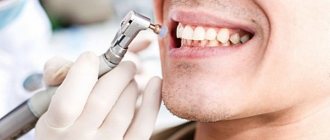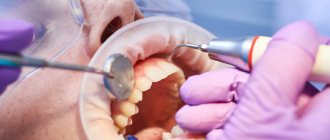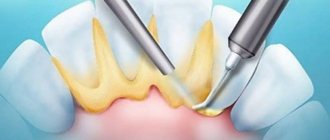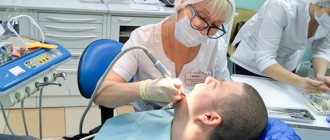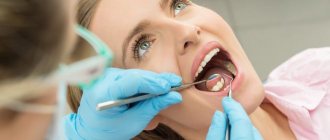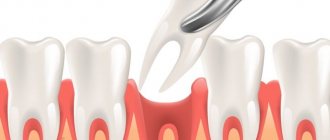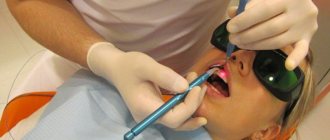Tartar not only disrupts the aesthetics of a smile, but leads to gum disease, bad breath, the development of dental caries and, in advanced cases, tooth loss.
Regular teeth cleaning using ultrasound removes hard plaque from the surface of the teeth and from shallow periodontal pockets (maximum up to 5 mm), the procedure is carried out using a special device - a dental scaler (scaler). The device can be built into a dental unit or stand-alone.
An ultrasonic scaler consists of a control unit and vibration generation unit, a handpiece, removable (replaceable) attachments and a control pedal. The device is equipped with a liquid supply system. During operation, the device creates ultrasonic vibrations with a frequency of 25-30 kHz, which are transmitted to the tip nozzle.
Physical principle of operation: an ultrasonic wave is transmitted from the tip to the scaler nozzle, which in turn transfers it to dental plaque. Under its influence, deposits are destroyed from the inside. To prevent damage to tooth enamel, the dentist moves the attachment strictly along the surface of the tooth. The simultaneous supply of water to the zone of ultrasound influence provokes the effect of cavitation, the formation of micro-bubbles in the volume, which accelerate the process of destruction of tartar. At the same time, water or a medicinal solution helps wash away dental plaque destroyed by ultrasound from the treatment area.
Types of Tartar
Tartar has its own classification - according to the field of education. Based on this feature, mineralized deposits are divided into two types:
- Subgingival calculus. Deposits accumulate under the edge of the gums, in the area of the gum pockets. A characteristic feature of subgingival tartar is its increased hardness. Mineralized subgingival deposits can cause an active inflammatory process in the periodontium (soft tissues of the oral cavity) and lead to gingivitis or periodontitis. It is impossible to remove subgingival stone at home: only a dentist can remove deposits in this area;
- Supragingival tartar forms above the gum level and is therefore clearly visible on the teeth. It can become stained from contact with food, and in smokers it has a distinct yellow or brown color. Supragingival tartar harms the healthy state of enamel, increases the risk of caries and, of course, spoils the appearance of teeth. It needs to be removed urgently, because the longer the stone is on the teeth, the denser and harder it becomes.
Symptoms such as the appearance of bad breath, discoloration of the gums, heavy plaque on the teeth after eating, and roughness of the teeth may tell you that tartar has formed on your teeth. If you observe such signs in yourself, be sure to contact the dentist for tartar removal and professional oral hygiene!
How to do ultrasonic teeth cleaning in our clinic
Typically, the procedure is recommended by a dentist after examining the oral cavity. Tartar deposits are removed for hygienic purposes, if the patient complains of discomfort, bleeding gums and bad breath. In addition, the treatment of gum inflammation (periodontitis) is not complete without ultrasonic teeth cleaning; the procedure can also be prescribed in order to increase the effectiveness of the treatment of caries and its complications.
Stages of teeth cleaning:
- Anesthesia. In most cases, the patient does not experience pain during ultrasonic treatment of teeth, but with exposed roots, enamel erosion or a large number of stones (especially under the gum), pain relief cannot be avoided. In our clinic, for this purpose, we use an anesthetic gel, which is generously lubricated on the gums, and we also administer injection anesthesia with drugs that do not cause side effects.
- Patient preparation. The stage consists of installing a retractor - a device that makes the treatment process comfortable for the patient, who does not have to strain to keep his mouth open, and for the doctor, who gets a good view of the oral cavity. To prevent the red border from drying out, the client's lips are lubricated with cream.
- Removing hard dental deposits . In our clinic, the Piezon Master 600 ultrasonic scaler (EMS, Switzerland) is used for the procedure. During cleaning, crushed deposits are washed off with water.
- Removing soft plaque . Ultrasound easily crushes stones, but it cannot completely remove plaque, at least not as thoroughly as an Air Flow sandblaster. At this stage of cleaning, the dentist treats each tooth and interdental spaces with a pressurized air-water jet to which abrasive powder (sodium bicarbonate) has been added. After this treatment, the teeth are finally rid of all types of deposits, including pigmented ones, for example, those formed due to drinking coffee and smoking.
- Treatment of spaces between teeth . In principle, the main work of cleaning the side surfaces has already been done, but going over them with superfloss (professional dental floss) and strips (sanding strips) will not be superfluous, especially since these devices not only clean, but also polish the surface.
- Final polishing. The shine and radiance of clean teeth is, in fact, what the patient wants to see, moreover, this is exactly the result he expects from the procedure. For polishing after ultrasonic cleaning of enamel, dental brushes and rubber bands attached to the drill attachment, as well as a special paste, are used.
- Antiseptic treatment and application of fluoride gel (to reduce tooth sensitivity and protect against caries).
Typically, ultrasonic teeth cleaning in our clinic takes about an hour, but in some cases it lasts up to an hour and a half. After the procedure, gums may bleed when brushing, as well as increased sensitivity of the teeth - these sensations disappear within one to two weeks. The best way to keep them to a minimum is to follow your doctor's recommendations and use the pastes, brushes and rinses indicated by him.
Methods for removing tartar used in dentistry
Previously, only mechanical cleaning was used to remove tartar in dentistry, which involved the use of special hand tools: scalers, curettes, excavators, smoothers, chisels, rasps. The procedure was labor-intensive, long and painful for the patient, and also very traumatic.
When manually removing tartar, a fairly large layer of healthy tissue was removed from the teeth and this led to unpleasant sensitivity of the teeth and thinning of the tooth enamel. Nowadays, mechanical removal of tartar is used extremely rarely, only in cases where the patient has contraindications to other methods of cleaning teeth from deposits.
Another outdated and rarely used method of removing plaque is to clean teeth from plaque using special chemical solutions.
The teeth were treated with preparations based on alkalis or acids that dissolve mineralized deposits. However, the chemical method of removing tartar is aggressive, it carries a high risk of burns to the soft tissue of the oral cavity, it negatively affects the condition of tooth enamel, so dentists have long abandoned its use. Nowadays, two modern and highly effective methods are used to remove tartar - ultrasonic cleaning and laser cleaning. We will tell you about these technologies in detail below.
How to clean teeth with ultrasound: stages
Your very first step is to go to the dentist. The doctor will do the rest.
The procedure is carried out in several stages:
- applying an anesthetic gel to the surface of the teeth - if necessary;
- directly removing tartar from enamel;
- treatment of subgingival pockets;
- grinding using special pastes;
- polishing - at the request of the patient.
The stone is removed under the action of a scaler with the simultaneous supply of a stream of water.
Modern techniques involve the use of the Air-Flow method together with ultrasound. After hard deposits have been removed, it is possible to treat the teeth with a water-abrasive mixture under pressure. Microscopic soda crystals penetrate even the interdental spaces, clean hard-to-reach places well, and polish the enamel.
The combined use of ultrasound and Air-Flow ultimately gives excellent results. The surface of the teeth becomes smooth, deposits disappear, the teeth look well-groomed, and the smile becomes beautiful.
Important. You should not uncontrollably (and also under control) rub your teeth with soda powder. In this case, you are guaranteed to have thinning enamel, but the deposits will remain in place.
Ultrasound removal of tartar
Ultrasonic tartar removal is a technology that allows you to quickly and painlessly remove mineralized plaque without damaging tooth enamel. The procedure will use a special ultrasonic device with a tip - a scaler. The generator in the device creates ultrasonic waves, which are transmitted to the scaler. The frequency of the waves can be adjusted, which gives the dentist the opportunity to choose the most effective and safe mode of operation.
When removing tartar with ultrasound, different types of tips can be used. By changing the tips, the dentist will clean the outer part of the teeth from mineralized deposits and remove plaque in the subgingival area. Effective and rapid removal of tartar is due to a double action:
- An ultrasonic wave is applied to the tip with a certain frequency, creating vibrations that destroy tartar mechanically;
- Since ultrasonic cleaning can be carried out using liquid, the simultaneous supply of water and ultrasonic waves leads to the effect of cavitation or, in simple words, the formation of a large number of microbubbles that loosen tartar and improve the process of its separation from tooth enamel.
The scalers of modern ultrasonic devices are equipped with illumination, which improves the quality of tartar removal.
Why is it worth having a dental cleaning in St. Petersburg at the GrandMed clinic?
Ultrasonic teeth cleaning is a popular procedure offered by all dental medical institutions. Our clinic also provides this, and guarantees the patient gentle teeth cleaning using modern technologies and equipment and, as a result, a result that lasts up to six months.
Our advantages:
- Dentists of the highest category, qualified mid-level medical personnel and friendly administrators will do everything to ensure that ultrasonic teeth cleaning is performed efficiently and at a time convenient for you.
- Modern and safe anesthesia will make ultrasound cleaning as comfortable as possible. The treatment will not cause discomfort in patients with exposed roots, enamel erosion, or with obvious signs of periodontitis. I would also like to draw attention to the fact that the drugs used (Ultracain, Ubestezin, Scandonest) extremely rarely cause allergies and rapid heartbeat in patients.
- To remove hard plaque in our dentistry, we use an ultrasonic device made in Switzerland, Piezon Master 600 - one of the best scalers, which allows you to ideally clean both the visible and “hidden” parts of the tooth from the eyes. And to remove soft deposits, another device from the same manufacturer, Air Flow, is used, which works on the principle of sandblasting.
- Safety of ultrasonic teeth cleaning. We have no shortages of disposable consumables, and reusable instruments are thoroughly processed using the latest sterilization equipment.
- The interior of our clinic, namely: soft light, warm shades used in the decoration of the walls, comfortable furniture and unobtrusive music will create the mood and allow you to tune in to the procedure.
- Reasonable price for dental cleaning in St. Petersburg.
Benefits of ultrasonic tartar removal
Ultrasonic tartar removal technology has the following advantages:
- It is highly effective; using ultrasound, it is possible to remove tartar from both the external surfaces of the teeth and the subgingival space;
- When removing tartar, ultrasound does not injure or damage tooth enamel;
- Ultrasound destroys pathogenic microflora in the oral cavity, and therefore removal of stone and plaque by ultrasonic cleaning is an excellent prevention of various dental diseases;
- The procedure for removing tartar using ultrasound is quick and painless for the patient.
The advantages of ultrasonic tartar removal include the affordable price of the service. Ultrasonic cleaning is universal and can be carried out as an independent hygienic procedure or in combination with Air Flow cleaning. It is imperative to remove tartar with ultrasound before dental treatment, prosthetics, implantation, or wearing braces.
Contraindications
A significant drawback of the procedure is the presence of contraindications. The doctor will definitely ask if you have any diseases or orthopedic structures, the presence of which implies a refusal to carry out cleaning.
Contraindications in this case include:
- acute bronchitis, asthma;
- diseases of the heart and blood vessels, installed pacemaker;
- infectious diseases, including ARVI;
- first trimester of pregnancy;
- presence of implants, bridges, braces;
- in a separate line – epilepsy, hepatitis, HIV.
It is also not recommended to perform the procedure on children's baby teeth.
Laser tartar removal
Laser tartar removal has been used in dentistry relatively recently. This technology involves removing mineralized deposits with a directed laser beam. The procedure is quick, painless and has the following advantages:
- High security. The laser beam destroys only plaque and does not damage the enamel and soft tissues of the oral cavity;
- Laser radiation destroys pathogens and stops inflammatory processes;
- Laser tartar removal takes place without discomfort or pain.
The disadvantages of laser tartar removal include a fairly large list of contraindications and the high cost of the procedure.
What is included in the professional comprehensive hygiene procedure at the Complete Order clinic?
- Removal of soft pigmented plaque using the PROPHYflex device (Profiflex) from the German company KAVO.
It effectively lightens teeth to their natural shade, eliminates smoker's plaque, yellowing of teeth from coffee and tea.
The principle of operation of the device is similar to the principle of sandblasting. An air-water mixture based on calcium carbonate is gently applied under pressure to the tooth through a nozzle attachment. When the mixture hits the surface of the tooth, it cleanses the enamel and is immediately removed from the mouth with a dental vacuum cleaner. Unlike calcium bicarbonate (baking soda), calcium carbonate powder has rounded particles; they gently polish the surface of the enamel without scratching it. We use only original powders from a German manufacturer with different flavors.
2. Removal of hard supragingival and subgingival dental calculus using ultrasound.
The vibrating part of a special tool - a scaler - oscillates at a frequency of 25,000-30,000 Hz. Under the influence of such vibration, dental deposits themselves peel off from the enamel surface and are easily removed by a doctor. A pleasant side effect is that ultrasound kills all microorganisms on the surface of the teeth.
Contraindications for the use of ultrasound are cardiac pacemaker and diabetes. A relative contraindication is pregnancy.
3. Polishing teeth with Cleanic paste from KAVO.
Air Flow for removing tartar
Air Flow is a technology used for professional teeth cleaning. It copes well with pigmented soft plaque, helps lighten tooth enamel to its natural shade, refreshes and disinfects the oral cavity. But with so many advantages, Air Flow is ineffective in the fight against tartar.
If a large amount of hard dental deposits have accumulated in the patient’s oral cavity, to remove them, properly clean with ultrasound or laser and only then use Air Flow.
Chemical method
The chemical method of removing stones is an auxiliary method that is used in combination with other methods. Its essence is that if the stones are very hard, they are first softened using special acidic chemicals. Applied to the surface of the stone, they effectively and quickly dissolve part of the stone within a minute. After which the stone can be easily removed using an ultrasonic tip.
Benefits of chemical stone removal:
- Risk reduction - the chemical method softens the stones and makes them easier to remove. This reduces the risk of injury with the ultrasound method.
- Whitening effect - after exposure to acids on tooth enamel, the tooth becomes 2-3 shades lighter
- Time saving – the process takes from 30 to 60 seconds.
Flaws:
- This method has one significant drawback. When in contact with tooth enamel, the acids used in this technique have a negative effect on the protective mechanisms of the teeth, as a result of which the tooth can easily deteriorate.
Is it possible to remove tartar at home?
On the Internet you can find countless recipes that claim to help remove tartar. Most of these recipes involve the use of caustic substances that must be applied to the surface of the teeth and, under the influence of these substances, the tartar should dissolve.
But we do not advise you to conduct such experiments on your health. Using caustic solutions will not help you remove tartar, but it will weaken and destroy tooth enamel and can lead to burns of the soft tissues of the mouth and other unpleasant consequences. In addition, no folk remedies will relieve you of subgingival tartar.
You need to remember that tartar removal should be carried out in a dental clinic, by a competent hygienist who uses safe materials and modern tools in his work! There is no need to be afraid of this procedure - it is painless, and in addition, before removing tartar, you can always apply local anesthesia, which completely removes all possible unpleasant sensations.
Benefits of ultrasonic teeth cleaning
The first devices for ultrasonic teeth cleaning, which appeared in the 60s of the last century, were somewhat imperfect, and after their use, damage to the enamel could occur. Therefore, plaque and tartar were often cleaned manually. Modern ultrasonic units are absolutely safe; they are used not only for removing tartar, but also for removing crowns, minimally invasive preparation of enamel areas affected by caries, and caring for dental implants.
The benefits of ultrasonic teeth cleaning include:
- Painless;
- Safe and complete removal of plaque in small periodontal pockets and on the surface of teeth;
- Impact exclusively on problem areas;
- The ability to regulate the strength of ultrasound;
- A variety of tips designed to work on different areas of the tooth surface;
- High hygiene of the procedure;
- Automatic adjustment of the system to the load;
- A quick and easy procedure that can be performed by a hygienist. Complex cases with deep periodontal pockets are not considered here;
- Affordable price.
Prevention of tartar formation
Is it possible to prevent tartar from forming? This question is often asked to dentists by patients after dental plaque removal procedures. Alas, there are no technologies in dentistry that would help get rid of tartar once and for all, but prevention can be carried out to promote the formation of deposits in smaller quantities and slow down the rate of their formation.
Effective prevention of tartar formation will include the following measures:
1. Regular brushing of teeth with the correct movements and the right toothbrush and toothpaste. If you don’t know which brush and paste are right for you, the dental hygienists of our clinic in Moscow, “Aesthetica”, will help you find the answer to this question!
2. When brushing your teeth, be sure to use dental floss or special brushes to help remove plaque and food debris from the spaces between your teeth.
3. Buy irrigators that help remove plaque from the subgingival space.
4. Stop smoking, drinking alcohol frequently, reduce the amount of sweet foods in your diet, and eat solid foods.
To remove tartar in a timely manner, visit the dentist once every six months and carry out professional oral hygiene procedures.
Is it painful to brush your teeth with ultrasound?
The procedure is considered painless, but may cause some discomfort if the enamel is sensitive. If the patient has a high pain threshold, he may well do without anesthesia. But in most cases, the dentist applies a special gel to the surface of the teeth. Also, applying water to the tooth when exposed to a scaler helps reduce pain.
Stone removal with 20% discount
Moscow
Will my teeth hurt after brushing?
No, no and NO. On the contrary, all patients, without exception, note extraordinary freshness in their mouth after the procedure. If you can say – even a feeling of lightness. The removed deposits do not put pressure on the enamel, and the feeling of tension in the teeth disappears.
When exposed to a scaler and a water-abrasive mixture under pressure, the gums are massaged. Blood circulation is normalized in the soft tissues, which also provides noticeable comfort in the mouth.
In general, ultrasonic cleaning is great. Having done it at least once, you will come to the dentist once every six months as required. Please note, come with pleasure.
Comprehensive teeth cleaning: service from our dentistry in Moscow “Aesthetica”
To ensure high-quality removal of tartar, we offer our patients a comprehensive teeth cleaning service, which includes:
- Ultrasonic cleaning;
- Air Flow cleaning;
- Grinding and polishing of enamel;
- Fluoridation.
An integrated approach to teeth cleaning guarantees a high quality procedure and is an excellent prevention of caries and gum inflammation. After the cleaning procedure, our hygienists will definitely give you recommendations on proper oral hygiene to help keep your teeth beautiful and healthy.
In our clinic, modern equipment is used to carry out comprehensive teeth cleaning, and all conditions have been created for comfortable treatment and procedures. We are proud that we can offer you the best dental technologies, high-quality materials from world-famous manufacturers and, of course, our professionalism, knowledge and experience.
Dental clinic “Aesthetica” - with us your teeth will be healthy and your smile will be dazzling! Come to us: we have opened two branches for you in Moscow - in Barvikha and in Podsosensky Lane!
Photos before and after ultrasonic teeth cleaning
Author: Elena Kopylova Dentist-therapist, endodontist. Work experience more than 8 years. The information is for reference only. Before treatment, consultation with a doctor is necessary.
Main stages of enamel processing
Before examining in detail how to clean and remove tartar with ultrasound, it is necessary to take into account some features of the procedure. So, for example, if a patient experiences inflammatory processes in the gum tissue, or there are signs of periodontitis, it is necessary for the periodontist to do the cleaning. The specialist must know how to properly remove the stone, including removing it from under the gums. If necessary, the doctor will prescribe anti-inflammatory therapy. The process of processing enamel also involves its subsequent mandatory polishing, and ideally also saturation with fluoride. Let's look at each stage in more detail.
Cleaning enamel with a scaler
A special device is used - an ultrasonic scaler (scaler or scaler). It can be a self-installation or a built-in part of dental equipment. The device is equipped with a special tip with a metal attachment, which, in turn, makes oscillatory movements (25-50 kHz) in the ultrasonic range1. The nozzle also provides a powerful stream of water to flush away any remaining deposits.
Surface polishing
The next and no less important stage after treating the enamel with an ultrasonic scaler. This effect on the surface of the teeth allows you to remove the smallest particles of plaque and stone. Currently, two main polishing methods are used in dentistry:
- with the help of brushes and pastes - with their help, all surfaces of the elements of the dentition are treated, and for the interdental spaces they resort to the help of special thin brushes - strips,
- Air Flow is a hardware technique that involves the use of a device of the same name that supplies a high-pressure stream of air and water with the addition of abrasive particles. It is worth noting that “Air Flow” is widely used as an independent method for gently cleaning enamel from soft plaque, and is also very often carried out after ultrasonic cleaning.
The photo shows teeth brushing with the Air Flow system.
The next important step is fluoride treatment. It is not always carried out, but it is desirable that the procedure is still included in comprehensive ultrasonic cleaning.
Treatment of enamel with a fluorine-containing composition - fluoridation
After treatment with ultrasound and Air Flow, teeth become especially susceptible to the effects of vitamins and minerals, which means that such a final procedure will have maximum effect. In addition, it will help reduce hyperesthesia in the cervical area - this is where the teeth become especially susceptible after removing hardened deposits. Fluoridation involves applying special gels and varnishes with a high concentration of fluorine and calcium to the enamel.
Fluoridation of teeth will strengthen enamel
Why is it so important to systematically remove stone?
We figured out whether it is painful to remove tartar and found out that there is nothing scary or painful in the procedure. But no less important is the question of why systematically undergo such cleaning using ultrasound. Experts have several good reasons to recommend regular use of this procedure.
Thus, plaque and tartar create a favorable atmosphere for the activity of bacteria, which begin to accumulate, including in subgingival pockets. If they are not removed in a timely manner, the situation will quickly only get worse, which will ultimately lead to the development of dental diseases - the occurrence of inflammatory processes and exposure of the roots. Next, pathological mobility of teeth may appear, bleeding gums, and your mouth will begin to smell bad. If treatment is not started, you may lose your teeth altogether.
The photo shows tartar on the back of the lower teeth.
